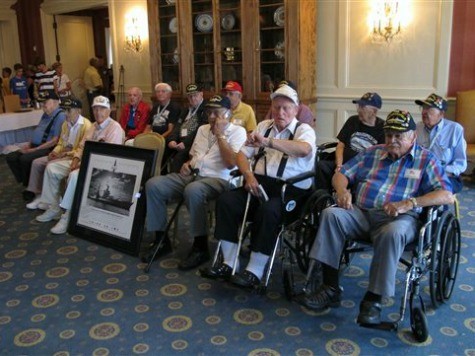(AP) USS Indianapolis survivors attend last big reunion
By RICK CALLAHAN
Associated Press
INDIANAPOLIS
More than a dozen men who survived the worst sea disaster in U.S. naval history _ the World War II sinking of the USS Indianapolis _ have gathered in the cruiser’s namesake city for the final large-scale reunion of the famed ship’s dwindling number of survivors.
Thirty-eight of the 317 men who survived the ship’s July 1945 sinking and five days in the Pacific’s shark-infested waters are still alive, but they’re now in their late 80s and early 90s and many use wheelchairs.
Harold Bray, an 86-year-old from Benicia, Calif., said he and the 14 other survivors attending this year’s reunion decided Friday that any future gatherings will be smaller and less frequent because so many of the survivors are in poor health.
Bray said the survivors will nonetheless keep telling the story of the ship’s sinking, their survival and the role they played in helping bring the war to a close.
The USS Indianapolis was halfway between Guam and the Philippines in shark-filled waters when a Japanese submarine sank it with torpedoes on July 30, 1945, in the war’s closing weeks.
Just days earlier, the Indianapolis had visited the island of Tinian in a secret mission to deliver the uranium-235 and other components for the atomic bomb later dropped on Hiroshima by the Enola Gay, which took off from the remote island.
The Indianapolis’ mission was so secret she sailed alone, unescorted by ships better equipped to detect and fight Japanese submarines.
An estimated 900 of the ship’s servicemen survived the vessel’s nighttime sinking, but before rescuers arrived five days later, drowning, delirium, dehydration and shark attacks had claimed all but 317 of the men.
The Indianapolis’ death toll _ 880 members out of a crew of 1,197 died _ is the U.S. Navy’s worst single at-sea loss of life. But reports of the tragedy were buried by the news of the Japanese surrender, and interest in the ship’s story was not revived until the 1975 movie “Jaws” featured a character who told of the sinking and the survivors’ days of agony.
Edgar Harrell, an 89-year-old from Clarksville, Tenn., who is one of only two ex-Marines among the remaining survivors, said the horrors he witnessed _ including sharks devouring men around him _ became too much for him to bear after he returned home.
While many survivors kept what they saw and heard to themselves, Harrell said the lingering trauma he’d suffered left him unable to focus on the college courses he enrolled in immediately after the war.
Clarence Hershberger, an 87-year-old survivor from De Leon Springs, Fla., who uses a wheelchair, hadn’t planned on attending the reunion, which ends Sunday. He’d been feeling poorly but decided Monday to make the trip to Indianapolis, where a black granite memorial honors the ship and its crew.
He said that when all of the survivors are gone he hopes the survivors’ relatives and others keep reminding the public about the ship and its crew’s sacrifice.
Among the roughly 250 friends and relatives of the survivors attending the reunion is Hunter Scott, whose seventh-grade history project as a 12-year-old from Pensacola, Fla., helped lead to a reassessment of the court-martial of the ship’s commanding officer, Rear Admiral Charles B. McVay III.
McVay was court-martialed for not sailing a zigzag course to evade submarines, but his men believed he was made a scapegoat. In 2000, 32 years after McVay committed suicide, Congress passed an act clearing his name.
Scott is now a 28-year-old Navy helicopter pilot based in California and he said the men’s incredible story of survival convinced him to enlist in the Navy.

COMMENTS
Please let us know if you're having issues with commenting.